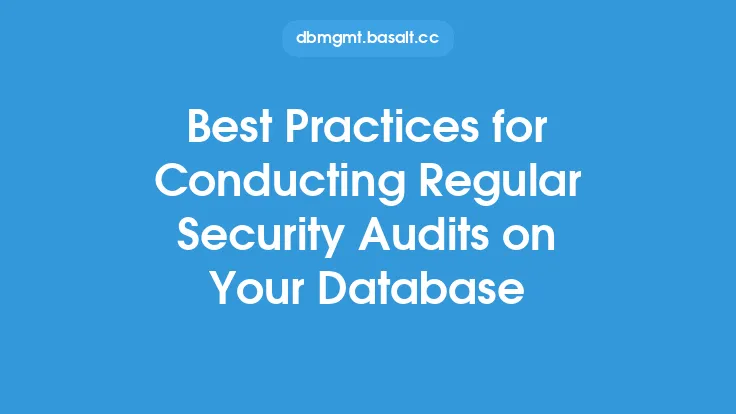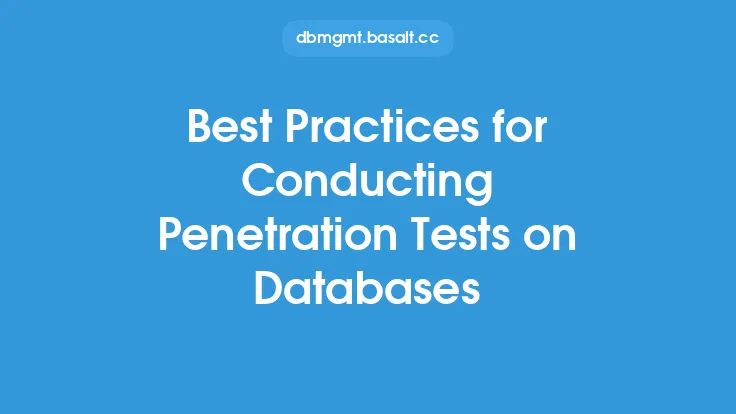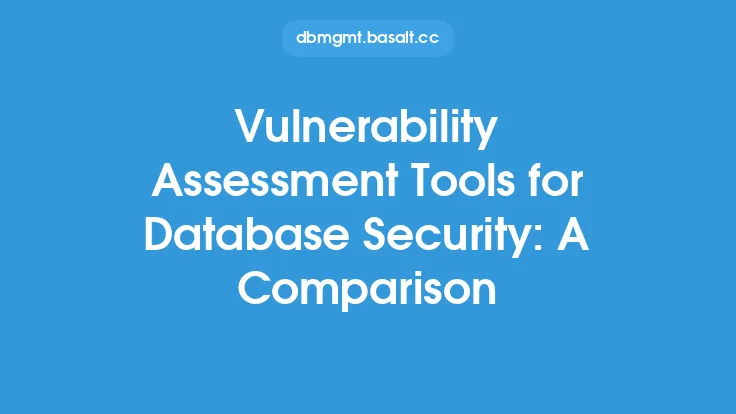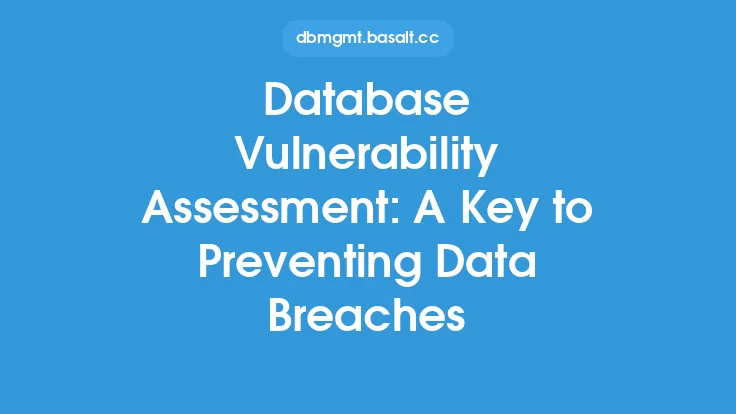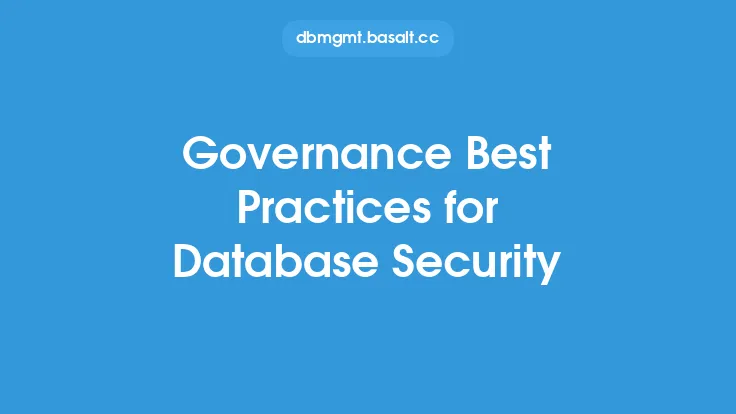Conducting a database vulnerability assessment is a crucial step in ensuring the security and integrity of an organization's database management system. This process involves identifying, classifying, and prioritizing vulnerabilities in the database, as well as providing recommendations for remediation. A thorough database vulnerability assessment can help prevent data breaches, protect sensitive information, and maintain the overall security posture of the organization.
Introduction to Database Vulnerability Assessment
A database vulnerability assessment is a systematic process that evaluates the database management system, its components, and its environment to identify potential vulnerabilities. This assessment can be performed manually or using automated tools, and it typically involves a combination of techniques, including network scanning, configuration analysis, and penetration testing. The goal of a database vulnerability assessment is to identify weaknesses in the database that could be exploited by attackers, and to provide recommendations for mitigating or remediating these vulnerabilities.
Pre-Assessment Preparation
Before conducting a database vulnerability assessment, it is essential to prepare the environment and gather necessary information. This includes identifying the scope of the assessment, gathering documentation about the database management system, and obtaining access to the database and its components. The assessment team should also develop a comprehensive understanding of the database architecture, including the network topology, system configurations, and security controls. Additionally, the team should establish clear goals and objectives for the assessment, and define the criteria for evaluating vulnerabilities.
Vulnerability Identification and Classification
The next step in the database vulnerability assessment process is to identify and classify vulnerabilities. This involves using various techniques, such as network scanning, configuration analysis, and penetration testing, to detect potential weaknesses in the database. The assessment team should use a combination of automated tools and manual testing to identify vulnerabilities, and should classify them based on their severity, impact, and likelihood of exploitation. Common database vulnerabilities include SQL injection, cross-site scripting, and buffer overflow attacks, as well as configuration weaknesses, such as weak passwords, outdated software, and inadequate access controls.
Vulnerability Analysis and Prioritization
Once vulnerabilities have been identified and classified, the assessment team should analyze and prioritize them based on their potential impact and likelihood of exploitation. This involves evaluating the severity of each vulnerability, considering factors such as the potential damage, the likelihood of exploitation, and the ease of remediation. The team should also consider the business criticality of the database, the sensitivity of the data, and the potential consequences of a security breach. Based on this analysis, the team should prioritize the vulnerabilities, focusing on the most critical and high-risk vulnerabilities first.
Remediation and Mitigation
After prioritizing the vulnerabilities, the assessment team should provide recommendations for remediation and mitigation. This may involve patching vulnerable software, updating configurations, implementing additional security controls, or providing training to database administrators. The team should also consider the potential impact of remediation efforts on the database and its users, and should develop a plan for implementing remediation measures with minimal disruption. Additionally, the team should establish a process for monitoring and verifying the effectiveness of remediation efforts, and for ensuring that vulnerabilities are properly mitigated.
Post-Assessment Activities
After completing the database vulnerability assessment, the assessment team should document the findings and recommendations, and provide a comprehensive report to stakeholders. The report should include an executive summary, a detailed description of the vulnerabilities, and recommendations for remediation and mitigation. The team should also conduct a post-assessment review, to evaluate the effectiveness of the assessment process, and to identify areas for improvement. Additionally, the team should establish a process for ongoing monitoring and assessment, to ensure that the database remains secure and up-to-date.
Best Practices for Database Vulnerability Assessment
To ensure the effectiveness of a database vulnerability assessment, several best practices should be followed. These include:
- Conducting regular assessments, to ensure that the database remains secure and up-to-date
- Using a combination of automated tools and manual testing, to identify vulnerabilities
- Classifying and prioritizing vulnerabilities, based on their severity, impact, and likelihood of exploitation
- Providing recommendations for remediation and mitigation, and establishing a process for implementing these measures
- Documenting the findings and recommendations, and providing a comprehensive report to stakeholders
- Establishing a process for ongoing monitoring and assessment, to ensure that the database remains secure and up-to-date
- Considering the business criticality of the database, the sensitivity of the data, and the potential consequences of a security breach
- Evaluating the potential impact of remediation efforts on the database and its users, and developing a plan for implementing remediation measures with minimal disruption.
Common Challenges and Limitations
Despite the importance of database vulnerability assessment, several challenges and limitations can arise. These include:
- Limited resources, including time, budget, and personnel
- Complexity of the database environment, including multiple systems, configurations, and security controls
- Limited visibility into the database environment, including lack of documentation, inadequate logging, and insufficient monitoring
- Difficulty in prioritizing vulnerabilities, due to limited information about the potential impact and likelihood of exploitation
- Limited expertise, including lack of knowledge about database security, vulnerability assessment, and remediation
- Resistance to change, including reluctance to implement remediation measures, or to modify existing configurations and security controls.
Future Directions and Emerging Trends
The field of database vulnerability assessment is constantly evolving, with new technologies, techniques, and best practices emerging regularly. Some of the future directions and emerging trends in this field include:
- Increased use of automation, including automated tools and machine learning algorithms, to identify and prioritize vulnerabilities
- Greater emphasis on cloud-based databases, including cloud-native databases, and cloud-based vulnerability assessment tools
- Increased focus on DevOps and continuous integration, including integrating vulnerability assessment into the development lifecycle
- Greater emphasis on security orchestration, including automating remediation efforts, and integrating vulnerability assessment with incident response
- Increased use of artificial intelligence, including AI-powered vulnerability assessment tools, and AI-driven remediation efforts.
